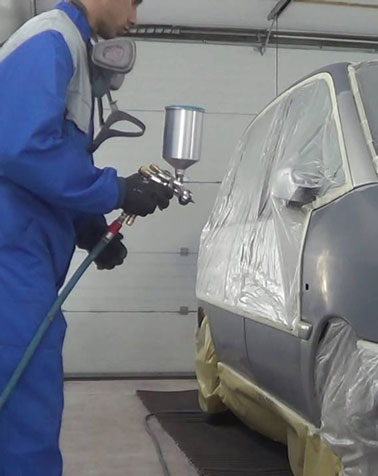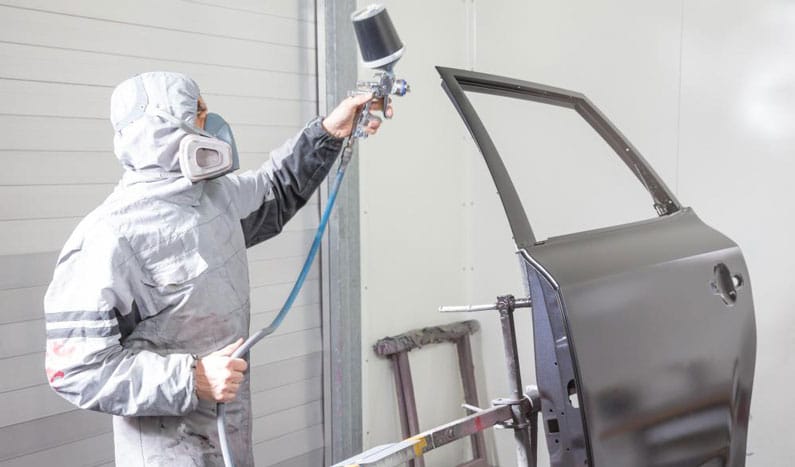
LVLP spray guns are great for a wide variety of applications including painting a car. However, it’s not as simple as it seems, especially if you have no previous experience. Dealing with high-quality materials requires quite a bit of knowledge as well as a fair amount of experience. However, this should not discourage you from tackling a project that includes painting a car, but you should take a moment and check some of the guidelines we’ve provided in order to prevent unfavorable results.
This guide is designed to offer a deeper insight into the do’s and don’ts when it comes to painting cars, but it’s definitely not a course you should blindly follow. We recommend that you watch some videos and read other guides in addition to this particular one in order to get as much information as possible. Needless to say, you must prepare for a certain amount of failed attempts as this application requires quite a bit of training and experience.
Setting up the space
The first thing you should think about is the protection of both environment, pieces you’re going to paint, and your health. It’s almost mandatory to tackle this endeavor inside your garage, but if you don’t have one, it’s necessary for you to paint in a somewhat confined space. For example, you should never paint in an open space (e.g., in front of your house) due to several reasons, the main being – dust particles.
As far as dust goes, it’s probably the number-one enemy of car painters. Even one dust particle can ruin the whole project because it’s extremely visible on freshly painted parts. In order to prevent this from happening, you should utilize your air compressor and clean up the space, several times. In fact, after blowing the dust out, it’s highly recommended that you hose the floor with water. Once it dries, use your compressor to blow the remaining dust particles once again. We cannot emphasize enough how important it is to eliminate dust because it takes a small moment of error in judgment to ruin the whole endeavor.
After dealing with dust, it’s time to protect the things inside the garage with either foil or any other type of sheeting. It’s recommended that you cover the entire space with plastic foil or at least cover as much as you can. While it’s well-known that LVLP spray guns have little overspray, it’s still a valid concern, especially if you don’t want any paint particles on your shelves, walls, doors, etcetera.
Proper ventilation is also one of the essential measures one should take, and yet many people either forget about it or simply decide against it. While you should never paint in an open space, you should also never paint in a completely enclosed garage, even if you’re wearing a mask. Most garages usually have some sort of ventilation, but that’s not enough. However, a conventional portable house fan should offer enough ventilation alongside the existing ventilation ports.
Last, but definitely not least, you should always think about your health. That means wearing a breathing mask at all times as well as gloves. While wearing gloves doesn’t sound too relevant, there’s a good reason why the vast majority of professionals wear them. One of those reasons that comes to mind is tied with skin irritation and accompanying issues.
Setting up the equipment
Now that you’ve created a nice environment, it’s time to fine-tune your equipment. The first step in this process involves pressure adjustment. Most people have a pressure gauge at the end of the hose, and it’s the only way one can truly fine-tune a spray gun. Doing that by following your instincts and guts is a big mistake, even if you have years of experience. Therefore, always make sure to hook up a pressure gauge onto the hose and as it is the only way you can be sure everything is set up correctly and accordingly.
Before applying the first layer of paint, always do a test run on a piece of metal you don’t need. It’s a matter of common sense, but you would be surprised by the number of people who forget about it. Not doing so consequently leads to very annoying issues that include unnecessary sanding and tedious corrections.

Painting individual pieces
You should always break the car apart as much as possible. That means you should end up with an empty chassis and a pile of disassembled parts.
The order by which you’re going to paint these pieces, as well as the chassis, doesn’t really matter much. In simpler words, you can paint the chassis first and then the parts or vice-versa. When dealing with the parts, make sure they are positioned correctly and that they aren’t touching the ground. Needless to say, everything should be dust-free during this process as well. There is a good chance you will need at least three layers of paint for each part including the body.
The first layer usually consists of primers, while the other two include the paint itself. Depending on what kind of finish you’re looking for as well as the quality of the paint, you may need up to four or five layers. It’s important to remember that every part should be completely dry before applying the next layer. Painting on top of a fresh layer won’t yield good results.

The conclusion
While we haven’t offered a complete and professional guide on how to paint a car using an LVLP spray gun, these guidelines should be a good starting point for individuals that don’t have much experience with these tools. Painting a car isn’t a process that consists of strict rules that should be followed, but some basic concepts should be kept in mind.
In case you aren’t sure how to deal with unforeseen predicaments, don’t hesitate to watch a couple of videos of professionals that already dealt with same issues. As mentioned, you will have to go through some trial and errors before achieving optimal results. The main thing to remember is not to give up too easily.
The post How to Paint a Car Using a LVLP Spray Gun appeared first on Tool Nerds.
from Tool Nerds https://ift.tt/2IdWlbT
via IFTTT
No comments:
Post a Comment